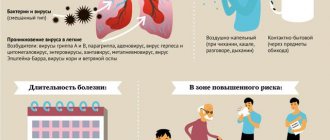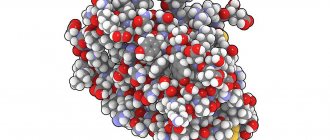Pneumonia is a serious inflammatory lung disease that is quite common these days. Despite the fact that, thanks to modern medicine, the treatment prognosis is generally favorable, with pneumonia there is a risk of developing dangerous complications and death. It is important to know how to protect yourself from this disease, and what precautions should be taken when in contact with a patient with pneumonia. It is better to prevent any disease than to eliminate the consequences of infection in the future.
The human upper respiratory tract is the habitat of numerous microorganisms, including opportunistic bacteria. In a normal state of immunity, there is a certain balance of microorganisms, and opportunistic microbes do not multiply. When the immune system is weakened, a person becomes ill.
Pneumonia develops as a result of airborne infection in people with weakened immune systems. The disease can occur in people who are under stress or due to severe fatigue. Viral infections can begin as influenza or adenovirus infection and then progress to pneumonia. With the active activity of pathogenic bacteria, inflammation of the walls of the bronchi and alveoli develops.
Pneumonia can develop when infected with mycoplasma bacteria, chlamydia, and other atypical microorganisms. Children and young people under the age of 25 are more susceptible to mycoplasma pneumonia. The most common cause of community-acquired pneumonia is streptococcal infection.
How does the disease occur?
Pneumonia is caused by bacteria, viruses and pathogenic fungi. The most common infectious agents include:
- pneumococci,
- staphylococci,
- streptococci,
- legionella,
- mycoplasma,
- hemophilus influenzae,
- flu,
- parainfluenza,
- cytomegalovirus,
- herpes,
- yeast-like fungi of the genus Candida.
Inflammation most often develops against the background of a respiratory infection, bronchitis or influenza. In this case, pneumonia acts as a complication. It is also not uncommon for pneumonia to develop as an independent disease. The development of pathology is facilitated by a weakening of the immune system, which occurs as a result of:
- chronic diseases;
- age characteristics (children and elderly people);
- influence on the body of harmful substances (cigarettes, alcohol, various toxins).
When the body’s natural defenses are reduced, the infection easily penetrates cells and tissues and begins to actively multiply. The longer a person remains without treatment, the greater the extent of lung tissue that will be involved in the inflammatory process. Pneumonia is doubly dangerous in that it can develop at lightning speed, worsening the patient’s condition to critical within a few days. Therefore, it is very important to consult a doctor in time and undergo appropriate examination.
At the Yusupov Hospital, patients are provided with a full range of medical services: diagnosis, treatment, recovery after illness. The therapy clinic employs qualified therapists and pulmonologists who have extensive experience in treating pneumonia. Doctors at the Yusupov Hospital use effective methods of evidence-based medicine and high-tech equipment in their work, which allows them to achieve maximum results even in the most difficult cases.
Make an appointment
Is pneumonia viral and what is it?
Pneumonia is an infectious disease of a viral or bacterial nature, characterized by inflammation of the lung tissue and resulting from the penetration of various pathogenic organisms into the respiratory tract.
What viral pneumonia is becomes clear from the classification by etiological factor. Depending on the causative agent, pneumonia is classified into:
- bacterial;
- mycoplasma;
- leginella;
- chlamydia;
- viral;
- fungal.
Viral pneumonia occurs in approximately 50% of all cases of pulmonary inflammation. In children, the majority of the disease is caused by viruses – about 90% of the total. Among adults, viral pneumonia is less common. Mostly elderly people over 65 years of age are affected.
Typically, viral pneumonia is caused by influenza A and B viruses, in children it can be respiratory syncytial virus and the causative agents of chickenpox and measles. Less commonly, pneumonia is caused by parainfluenza viruses, adeno and coronaviruses.
Viral pneumonia can be primary or secondary, as a consequence of influenza and other viral infections.
Transmission routes
The causative agents of pneumonia (bacteria, viruses, pathogenic fungi) are able to pass from a sick person to a healthy person in various ways:
- airborne,
- through saliva,
- through blood
- through amniotic fluid, birth canal.
Person-to-person transmission
Pneumonia, as a separate disease, is considered non-contagious and is not transmitted from person to person. If we consider the root cause of the development of pneumonia, for example, influenza, then a healthy person can become infected with it. However, it is not at all necessary that the flu will develop into pneumonia in the future. This will depend on the state of the immune system. When pathogenic organisms penetrate the human body, its protective functions begin to actively fight them. If the immune system fails to cope, a complication of the disease occurs. In this case, the flu is complicated by pneumonia.
Bacterial and viral pathogens of pneumonia can enter the body through physiological fluids. This does not mean that infection with the pathogen will necessarily lead to the development of pneumonia, but the person is at risk.
Any factors that reduce the body’s natural defenses (various diseases, hypothermia, overwork, etc.) can provoke the development of pathology. Therefore, it is better to treat bacterial or viral infections, even if they are in a passive state. This recommendation especially applies to women planning pregnancy. Before conception, it is necessary to undergo examination to determine hidden infections. They may not manifest themselves in any way, but can be transmitted to the fetus during pregnancy or childbirth. In infants, the immune system cannot resist diseases, so they are more likely to develop pneumonia than adults, even if they have the same infectious agents in the body.
Airborne transmission
This issue should be highlighted separately, since it most often worries people who care for a patient with pneumonia. If we consider typical forms of pneumonia, then it cannot be contracted by airborne droplets. Viruses that cause pneumonia are transmitted through breathing. A person with a stable immune system will in most cases only survive a common cold. Bacteria that cause pneumonia are not transmitted by airborne droplets. Pneumonia can only occur if a person has a weak immune system.
If pneumonia is caused by tuberculosis (caseous pneumonia, classified as atypical), then there is a risk of infection through contact with a patient. The causative agent of this type of pneumonia is transmitted by airborne droplets and can cause disease in a weakened body.
For your own safety, when communicating with a patient with pneumonia (especially if you do not know the nature of the disease), you should use a mask. Also, a patient with pneumonia needs his own dishes to prevent transmission of the pathogen through saliva.
Treatment
The doctor decides how to treat viral pneumonia after making a diagnosis. First of all, the patient is prescribed bed rest and plenty of fluids - up to 3 liters of fluid per day.
. Patients of younger preschool and older age are subject to hospitalization, the rest are usually treated at home.
Therapy is carried out in two directions:
- etiological;
- symptomatic.
Etiological treatment is the fight against the cause of the disease, that is, a specific virus. The choice of drug depends on its type.
- For pneumonia caused by the influenza virus, the drugs Remantadine, Tamiflu or Relenza should be used.
- Measles and chickenpox viruses are treated with Acyclovir or Isoprinosine.
- Cytomegalovirus can be treated with Ganciclovir.
- For respiratory syncytial pneumonia, Ribavirin is prescribed.
- If there is a suspicion of a bacterial infection, the doctor prescribes macrolide antibiotics (Rovamycin, Rulid) or benzylpenicillin (Ampicillin, Flemoxin, Amoxiclav)
Symptomatic treatment depends on the severity of the various manifestations of the disease.
- Fever, aches in the joints and muscles are well relieved by antipyretic and painkillers Ibuprofen, Paracetamol in tablets or syrups for children, as well as complex drugs - Pentalgin, Fervex, Theraflu in tablets or powders.
- Expectorants Ambroxol, Acetylcholine, herbal preparations Gerbion, Linkas, Doctor Mom in the form of tablets, syrups, and solutions for inhalation will help relieve coughs and facilitate the discharge of sputum.
- For shortness of breath, oxygen therapy is prescribed - treatment with oxygen.
- In case of vascular insufficiency, a solution of cordiamine or caffeine is administered intramuscularly.
- Vitamins are prescribed both for prevention and during treatment.
- During the recovery period, the patient is required to undergo physiotherapeutic treatment.
Diagnostics
Among atypical pneumonias in adults, mycoplasma pneumonia occurs, which is most often diagnosed not immediately, but after some time. In the first days of development, atypical pneumonia is mistakenly diagnosed as bronchitis or acute respiratory infections. In the case of mycoplasma or chlamydial pneumonia, X-ray examination is not informative. This type of pneumonia is determined using a serological test or using PCR (polymerase chain reaction).
These types of microorganisms are difficult to determine using culture diagnostics - they belong to intracellular pathogens. The patient often has a dry cough with no sputum. Isolation of microorganisms from clinical material requires energy-rich media, and culturing bacteria requires a long incubation period—sometimes up to two weeks. Due to the ability of mycoplasma to survive for a long time in the human body, the isolation of bacteria does not confirm the acute phase of mycoplasma infection.
Mycoplasma infection in most cases ends in recovery, which cannot be said about mixed types of infections, which are very difficult. Most often, mycoplasma infection affects people in childhood and young age, less often before the age of 40, and very rarely after the age of 60. Most often, adults are diagnosed with pneumonia caused by streptococcus and chlamydia.
At the Yusupov Hospital, the patient undergoes a quick and effective diagnosis of the disease. The doctor of the therapeutic department conducts an examination and, if necessary, refers you to specialists for consultation to rule out pulmonary tuberculosis. The patient is prescribed the most effective antibacterial therapy for this case of pneumonia. Treatment of pneumonia should be carried out in a hospital setting under the supervision of a physician. You can make an appointment with a hospital specialist by calling the clinic.
What are the symptoms of viral pneumonia in adults and adolescents?
The symptoms of the disease at the beginning cannot be distinguished from acute respiratory diseases. At the first stage, viral pneumonia is accompanied by:
- high temperature;
- chills;
- aches in joints and muscles;
- sore throat;
- dry cough;
- shortness of breath and wheezing;
- general weakness;
- sharp pain behind the sternum.
At the second stage of the disease, a dry cough gives way to a wet cough with yellowish to rust-colored sputum. The temperature continues to remain high for 10-15 days.
Symptoms in adolescents do not differ from the manifestations of the disease in adult patients. Among schoolchildren and older youth, viral pneumonia is extremely rare.
Prevention
To protect yourself from pneumonia, you need to regularly follow simple rules that will also help you avoid other diseases:
- observe the rules of personal hygiene: wash your hands after going outside and using public transport, use hand sanitizers;
- eliminate bad habits. Smoking, alcohol abuse, and drug use have a detrimental effect on the condition of the entire body, in particular on the respiratory system;
- if you have chronic diseases, regularly visit your doctor to monitor the condition, since the constant presence of pathology negatively affects the immune system;
- lead a healthy lifestyle. Exercising, a healthy diet, and normal sleep help normalize the functioning of all organs and systems and strengthen the body's defense mechanisms.
When the first signs of the disease appear, you should immediately consult a doctor. At the Yusupov Hospital, patients are provided with all the necessary assistance to eliminate their illness. Effective treatment methods promote a speedy recovery and minimize the risk of developing negative consequences.
After suffering from pneumonia, the Yusupov Hospital offers to undergo a rehabilitation course, which allows you to normalize the body’s functioning much faster and restore its functions. You can make an appointment with a therapist, pulmonologist or rehabilitation specialist, or get advice from other specialists by phone.
Make an appointment
Is there a vaccine against this disease?
The vaccine against pneumonia is widely known and is one of the mandatory vaccinations for children, but it involves protecting the body from pneumococci. Accordingly, this vaccination protects against the bacterial form of the disease. And this vaccine alone is not enough to protect against viral pneumonia. There is no vaccine against this disease, as such. But there are vaccines against various viruses.
Since the same viruses can cause both influenza and pneumonia, the influenza vaccine can also be considered a vaccine against viral pneumonia.
It is known that influenza viruses are constantly modified, so vaccines are also regularly improved. Every year, drugs are created against the most common strains of the virus at the moment. In this regard, it is necessary to be vaccinated annually in the fall, no later than two weeks before the expected development of the seasonal epidemic. After using the vaccine, antibodies are produced in the body within two weeks.
Even if a vaccinated person is still infected, the disease will pass in a very mild form. It is impossible to become infected from vaccination, since the vaccine does not contain live bacteria or viruses.
Prognosis and mortality
Viral pneumonia is usually milder than bacterial pneumonia and usually ends with recovery. Cure occurs on average after two to three weeks.
About a third of patients stay sick longer, this is usually associated with the development of complications:
- addition of a bacterial infection;
- Chronical bronchitis;
- meningitis;
- encephalitis;
- pleurisy;
- lung abscess;
- otitis;
- pyelonephritis;
- obstructive bronchiolitis in infants.
All these complications can occur due to reduced immunity, previous diseases, as well as due to untimely initiation of therapy. The possibility of death is less than 1% and only among the risk group.
The sooner a patient sees a doctor, the less likely it is to get a complication of viral pneumonia!
Where can I get tested for Influenza, ARVI, Pneumonia?
In a multidisciplinary medical center you can always get examined for Influenza, ARVI, Pneumonia
. Our medical center is located between the Konkovo and Belyaevo metro stations (South-Western Administrative District of Moscow in the area of the Belyaevo, Konkovo, Teply Stan, Chertanovo, Yasenevo, Sevastopolskaya, New Cheryomushki metro stations " and "Trade Union"). Here you will find highly qualified personnel and the most modern diagnostic equipment. Our clients will be pleasantly surprised by our quite affordable prices.
ARVI
ARVI
is an acute respiratory viral infection known to everyone since childhood. The disease is caused by parainfluenza viruses, adenoviruses, rhinoviruses, reoviruses and other types of non-cellular infectious elements. The disease is transmitted by airborne droplets, as well as through unwashed hands after touching contaminated surfaces. People of any age are susceptible to ARVI. The incubation period for ARVI is on average from one to five days. The symptoms of the disease resemble the clinical picture of an acute respiratory infection, the cause of which is an infection that affects the ciliated epithelium of the human respiratory tract, entering the body along with air. However, in the case of acute respiratory viral infection, all painful symptoms appear more clearly and rapidly. This is a sharp increase in body temperature, severe chills and weakness, a feeling of aching muscles, a feeling of heaviness in the head, a painful reaction to light, severe lacrimation, discharge from the nasal cavity, pain in the nasopharynx and throat, frequent sneezing, upset stool. As the body produces antibodies to the virus, intoxication gradually weakens and the condition returns to normal. Possible complications of ARVI are rhinitis, sinusitis, otitis, neuritis, pneumonia, tracheitis.








